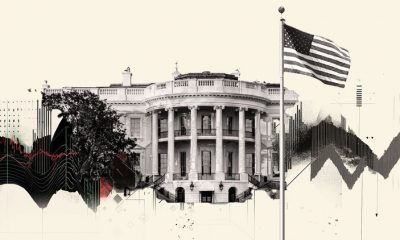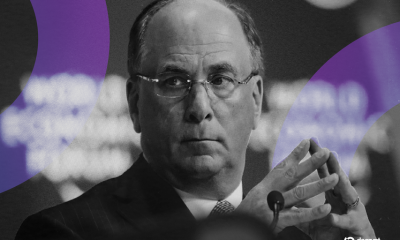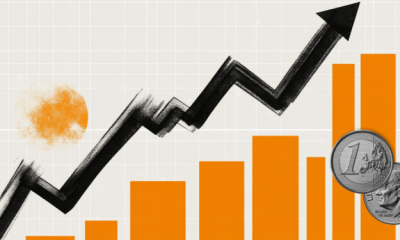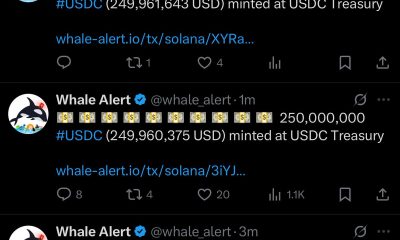

others
USD/INR loses momentum ahead of US CPI data – Crypto News
- Indian Rupee attracts some buyers on the weaker USD and robust foreign inflows.
- India is on track to become one of the top three global economies, Indian Prime Minister Modi said.
- The US Consumer Price Index (CPI) for December will be a closely watched event on Thursday.
Indian Rupee (INR) trades on a positive note on Thursday, supported by robust foreign inflows. On Wednesday, India’s Prime Minister Narendra Modi stated that India is set to become one of the top three global economies. Modi acknowledged India’s economic development as a decade of structural reforms that improved the country’s capacity and competitiveness amid global headwinds.
The highlight on Thursday will be the US inflation report, as measured by the Consumer Price Index (CPI). The stronger-than-expected inflation data could lift the US Dollar and potentially delay a rate cut from the Federal Reserve (Fed). On Friday, attention will shift to the December Indian CPI, Industrial Production, and Manufacturing Output.
Daily Digest Market Movers: Indian Rupee remains strong amid challenges from external factors
- The Indian government plans to cut its fiscal deficit by at least 50 basis points (bps) in fiscal year 2025.
- The Indian government plans to increase capital spending by up to 20% in fiscal year 2025.
- On February 1, Finance Minister Nirmala Sitharaman will unveil the 2024/25 budget.
- The World Bank kept its FY25 economic growth projection for India unchanged at 6.4%, owing to strong domestic demand, rising public infrastructure spending, and strong private-sector credit growth.
- Bloomberg Index Services proposed including eligible Indian bonds in its emerging market local currency index from September.
- Finance Minister Nirmala Sitharaman said on Wednesday that India is estimated to be a $5 trillion economy by 2027–28 and become the third largest economy.
- New York Federal Reserve (Fed) President John Williams said that interest rates in the US will likely need to stay high “for some time” until the central bank is confident that inflation is returning to 2%.
- Atlanta Fed Bank President Raphael Bostic emphasized that monetary policy needs to stay tight while inflation remains above the 2% target. Fed’s Bowman stated that the policy is sufficiently restrictive.
- The US Consumer Price Index (CPI) data for December will be due on Thursday at 13:30 GMT. The Core CPI is estimated to show an increase of 3.8% YoY, while headline inflation is projected to grow 3.2% YoY versus 3.1% prior.
Technical Analysis: Indian Rupee could see a downleg in the shorter term
Indian Rupee trades strongly on the day. The USD/INR pair remains stuck within a multi-month trading range between 82.80 and 83.40. According to the daily chart, USD/INR resumes a bearish outlook in the shorter timeframe as the pair holds below the key 100-period Exponential Moving Average (EMA). Additionally, the downward momentum is supported by the 14-day Relative Strength Index (RSI) that stands below the 50.0 midpoint.
A breach below the 83.00 psychological level will see a drop to the critical contention level at 82.80, portraying the confluence of the lower limit of the trading range and a low of September 12. Further south, the next downside target is located at a low of August 11 at 82.60. On the other hand, the immediate resistance level for USD/INR will emerge near the upper boundary of the trading range at 83.40. A break above 83.40 will expose a 2023 high of 83.47, followed by the psychological figure at 84.00.
US Dollar price this week
The table below shows the percentage change of US Dollar (USD) against listed major currencies this week. US Dollar was the weakest against the Pound Sterling.
| USD | EUR | GBP | CAD | AUD | JPY | NZD | CHF | |
| USD | -0.35% | -0.40% | -0.02% | -0.09% | 0.44% | -0.09% | -0.13% | |
| EUR | 0.34% | -0.04% | 0.34% | 0.27% | 0.80% | 0.27% | 0.21% | |
| GBP | 0.38% | 0.03% | 0.37% | 0.30% | 0.83% | 0.30% | 0.25% | |
| CAD | 0.01% | -0.33% | -0.38% | -0.07% | 0.49% | -0.07% | -0.10% | |
| AUD | 0.07% | -0.27% | -0.31% | 0.07% | 0.55% | 0.00% | -0.04% | |
| JPY | -0.47% | -0.79% | -0.86% | -0.44% | -0.52% | -0.52% | -0.58% | |
| NZD | 0.07% | -0.27% | -0.31% | 0.07% | 0.00% | 0.53% | -0.04% | |
| CHF | 0.10% | -0.25% | -0.29% | 0.13% | 0.03% | 0.55% | 0.02% |
The heat map shows percentage changes of major currencies against each other. The base currency is picked from the left column, while the quote currency is picked from the top row. For example, if you pick the Euro from the left column and move along the horizontal line to the Japanese Yen, the percentage change displayed in the box will represent EUR (base)/JPY (quote).
RBI FAQs
The role of the Reserve Bank of India (RBI), in its own words, is “..to maintain price stability while keeping in mind the objective of growth.” This involves maintaining the inflation rate at a stable 4% level primarily using the tool of interest rates. The RBI also maintains the exchange rate at a level that will not cause excess volatility and problems for exporters and importers, since India’s economy is heavily reliant on foreign trade, especially Oil.
The RBI formally meets at six bi-monthly meetings a year to discuss its monetary policy and, if necessary, adjust interest rates. When inflation is too high (above its 4% target), the RBI will normally raise interest rates to deter borrowing and spending, which can support the Rupee (INR). If inflation falls too far below target, the RBI might cut rates to encourage more lending, which can be negative for INR.
Due to the importance of trade to the economy, the Reserve Bank of India (RBI) actively intervenes in FX markets to maintain the exchange rate within a limited range. It does this to ensure Indian importers and exporters are not exposed to unnecessary currency risk during periods of FX volatility. The RBI buys and sells Rupees in the spot market at key levels, and uses derivatives to hedge its positions.
-

 Technology1 week ago
Technology1 week agoChatGPT users are mass cancelling OpenAI subscriptions after GPT-5 launch: Here’s why – Crypto News
-

 Technology6 days ago
Technology6 days agoiPhone 17 series tipped to cost more than iPhone 16: Here’s how much it could cost in India and US – Crypto News
-
Cryptocurrency7 days ago
DWP Management Secures $200M in XRP Post SEC-Win – Crypto News
-

 Cryptocurrency7 days ago
Cryptocurrency7 days agoXRP gains legal clarity in US after Ripple settles SEC case – Crypto News
-
Business1 week ago
Analyst Predicts $4K Ethereum Rally as SEC Clarifies Liquid Staking Rules – Crypto News
-

 Blockchain1 week ago
Blockchain1 week agoShiba Inu’s Shibarium Is More Than A Layer 2, Expert Reveals What It Is – Crypto News
-
Business1 week ago
XRP Price Prediction As $214B SBI Holdings Files for XRP ETF- Analyst Sees Rally to $4 Ahead – Crypto News
-
others1 week ago
SEC Latest Filing Reveal Ripple Case Win Could Trigger XRP Treasury Boom Like Ethereum – Crypto News
-

 Technology1 week ago
Technology1 week agoHumanoid Robots Still Lack AI Technology, Unitree CEO Says – Crypto News
-

 others1 week ago
others1 week agoUS President Trump issues executive order imposing additional 25% tariff on India – Crypto News
-

 De-fi1 week ago
De-fi1 week agoRipple Expands Its Stablecoin Payments Infra with $200M Rail Acquisition – Crypto News
-

 Cryptocurrency1 week ago
Cryptocurrency1 week agoHarvard Reveals $116 Million Investment in BlackRock Bitcoin ETF – Crypto News
-
others3 days ago
Breaking: USDC Issuer Circle To Launch Arc Blockchain for Stablecoin Payments – Crypto News
-

 De-fi1 week ago
De-fi1 week agoSEC Says Some Stablecoins Can Be Treated as Cash, but Experts Warn of Innovation Risk – Crypto News
-

 De-fi1 week ago
De-fi1 week agoCoinbase Pushes for ZK-enabled AML Overhaul Just Months After Data Breach – Crypto News
-

 others1 week ago
others1 week agoEUR firmer but off overnight highs – Scotiabank – Crypto News
-
Business6 days ago
Trump’s World Liberty Financial Targets $1.5B Crypto Vehicle Backed by WLFI Tokens – Crypto News
-
others6 days ago
United Kingdom CFTC GBP NC Net Positions fell from previous £-12K to £-33.3K – Crypto News
-
Technology1 week ago
Shiba Inu Community Turns on Shytoshi Kusama, Says He’s “Unfit To Lead” Amid Elections – Crypto News
-

 Blockchain1 week ago
Blockchain1 week agoTrump to Sign an EO Over Ideological Debanking: Report – Crypto News
-
Business1 week ago
OpenAI Launches GPT-5 Amid Competition From Elon Musk’s Grok – Crypto News
-
Technology1 week ago
Breaking: XRP Lawsuit Ends as Ripple and SEC File Joint Dismissal – Crypto News
-

 others1 week ago
others1 week agoRipple To Gobble Up Payments Platform Rail for $200,000,000 To Support Transactions via XRP and RLUSD Stablecoin – Crypto News
-

 Technology1 week ago
Technology1 week agoHulu app to shut down in 2026 as Disney fully merges platform into Disney+ – Crypto News
-

 De-fi7 days ago
De-fi7 days agoCircle Mints About $1 Billion in USDC After Flurry of Treasury Moves – Crypto News
-
others6 days ago
Crypto Adviser Bo Hines Move to AI Role Sparks Concern Over White House Policy Shift – Crypto News
-

 Metaverse1 week ago
Metaverse1 week agoOpenAI launches gpt-oss-120b and 20b models that can work without the Cloud on your computers – Crypto News
-

 De-fi1 week ago
De-fi1 week agoSEC Says Some Stablecoins Can Be Treated as Cash, but Experts Warn of Innovation Risk – Crypto News
-
Technology1 week ago
Roman Storm Trial: Jury Fails to Reach Verdict on Money Laundering Charge – Crypto News
-
Cryptocurrency1 week ago
Ripple CTO Breaks Silence on Caitlin Long’s ‘XRP ICO’ Misconception – Crypto News
-
Technology1 week ago
Trump Tariffs: U.S. Imposes Another 25% Tariff on India – Crypto News
-
others1 week ago
SEC Commissioner Pushes Back on Crypto ETFs as XRP ETF Approval Odds Sink – Crypto News
-
Business1 week ago
Former Meta, Netflix Engineers Unite to Build a Blockchain For iPhone Like Revolution in Web3 – Crypto News
-
others1 week ago
Just In: Trump to Sign Executive Order Allowing Crypto in 401(k) Plans – Crypto News
-
others1 week ago
Robinhood Lists FLOKI Meme Coin As Market Cap Surpasses $1B – Crypto News
-

 Cryptocurrency1 week ago
Cryptocurrency1 week agoThis Ripple (XRP) Metric Flashes Critical Warning Sign – Crypto News
-
Technology1 week ago
Trump Removes IRS Commissioner, Pro Crypto Scott Bessent to Serve as Acting Head – Crypto News
-
Technology7 days ago
Ripple’s 4-Year Lawsuit Battle with the SEC Ends: Timeline, Turning Points, and the Final Verdict – Crypto News
-

 Cryptocurrency7 days ago
Cryptocurrency7 days agoBTC hovers at $115K; ETF flows turn negative, short-term holder profitability drops – Crypto News
-

 Cryptocurrency5 days ago
Cryptocurrency5 days agoCrypto investors hopeful amid new regulatory orders – Crypto News
-
Business5 days ago
Uniswap Proposes DUNI Legal Entity in Wyoming to Boost DAO Governance – Crypto News
-
Cryptocurrency4 days ago
Trump Mulls Lawsuit Against Powell Amid Fed Rate-Cut Push – Crypto News
-
Technology2 days ago
99% Approval Odds? How Close Are We to Spot Solana ETF Launch in US? – Crypto News
-

 others1 week ago
others1 week agoScammer Steals $507,916 From US Benefits Program, Leaving Dozens of Families in Financial Ruin: DOJ – Crypto News
-

 Cryptocurrency1 week ago
Cryptocurrency1 week agoTop Crypto Coin Prediction: BTC, ETH And TRX Defy Odds – Crypto News
-

 De-fi1 week ago
De-fi1 week agoSEC Says Some Stablecoins Can Be Treated as Cash, but Experts Warn of Innovation Risk – Crypto News
-
others1 week ago
Strategy Could Become Largest U.S. Public Company if Bitcoin Hits $1M: Tom Lee – Crypto News
-

 Technology1 week ago
Technology1 week ago‘The computer will see what we see’: Microsoft outlines bold AI shift in Windows 2030 vision – Crypto News
-

 Cryptocurrency1 week ago
Cryptocurrency1 week agoSEC staff statement on liquid staking may pave way for staking in spot Ether ETFs – Crypto News
-

 Blockchain1 week ago
Blockchain1 week agoXRP Whales Offload $1.9B Putting Price at Risk of Drop Toward $2 – Crypto News

![Car Group Limited – CAR Elliott Wave technical analysis [Video]](https://dripp.zone/news/wp-content/uploads/2025/05/Car-Group-Limited-–-CAR-Elliott-Wave-technical-analysis-Video-400x240.jpg)
![Car Group Limited – CAR Elliott Wave technical analysis [Video]](https://dripp.zone/news/wp-content/uploads/2025/05/Car-Group-Limited-–-CAR-Elliott-Wave-technical-analysis-Video-80x80.jpg)


![CSX Corp. (CSX) Stocks Elliott Wave technical analysis [Video]](https://dripp.zone/news/wp-content/uploads/2025/02/CSX-Corp-CSX-Stocks-Elliott-Wave-technical-analysis-Video-400x240.png)
![CSX Corp. (CSX) Stocks Elliott Wave technical analysis [Video]](https://dripp.zone/news/wp-content/uploads/2025/02/CSX-Corp-CSX-Stocks-Elliott-Wave-technical-analysis-Video-80x80.png)



